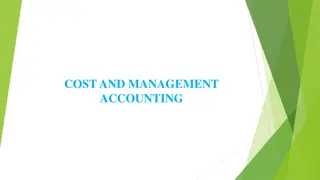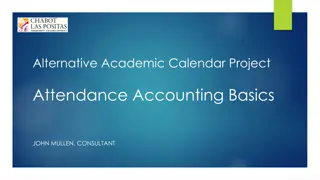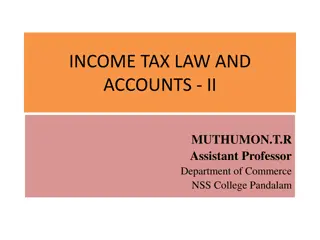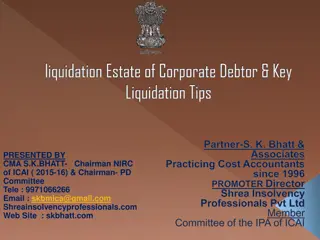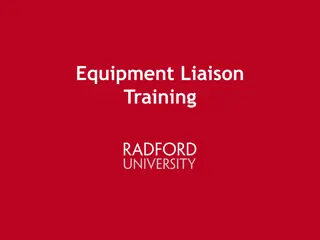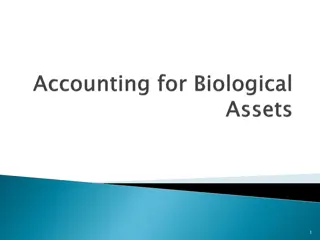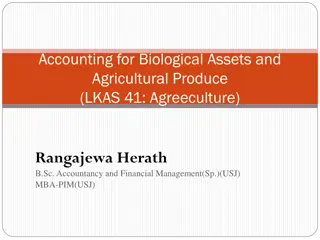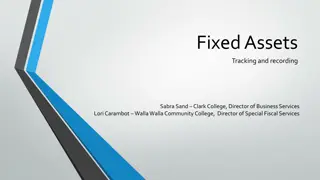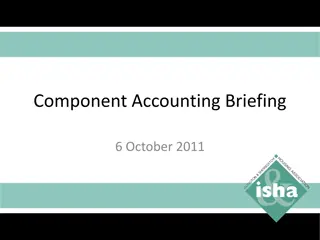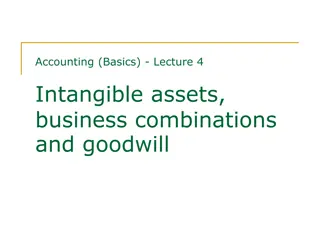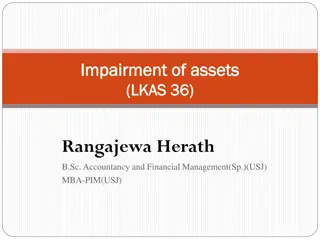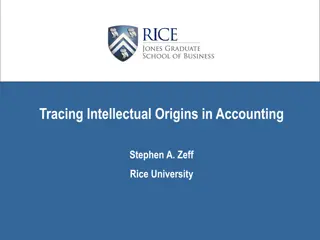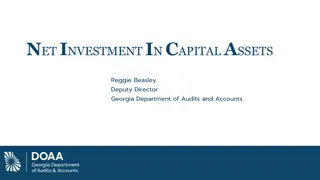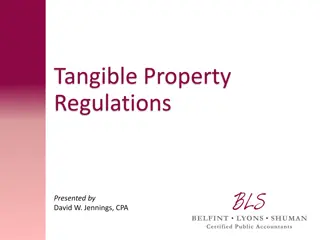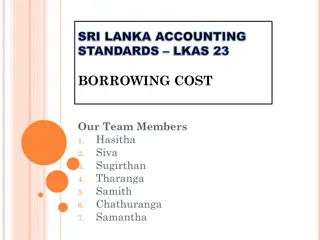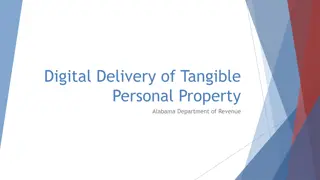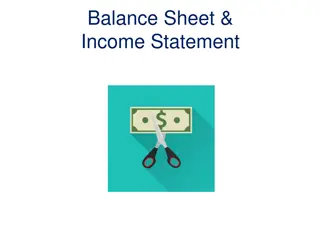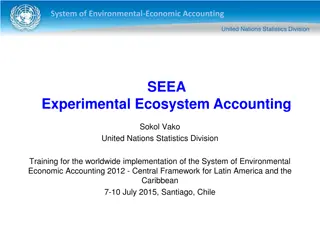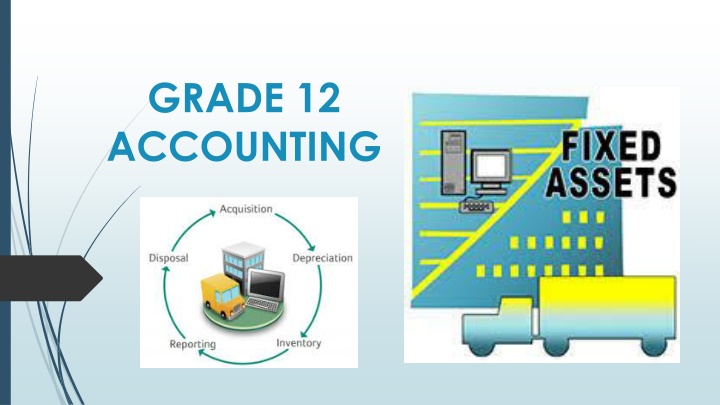
Understanding Fixed Assets in Accounting
Explore the world of fixed assets in accounting with topics such as assessing prior knowledge, depreciation policies, acquisition and disposal of fixed assets, and disclosure requirements in financial reporting. Get insights into the different categories and recording processes of fixed assets, along with case studies on integration, ethics, and internal controls. Enhance your knowledge on fixed assets' role in financial and managerial accounting.
Download Presentation

Please find below an Image/Link to download the presentation.
The content on the website is provided AS IS for your information and personal use only. It may not be sold, licensed, or shared on other websites without obtaining consent from the author. If you encounter any issues during the download, it is possible that the publisher has removed the file from their server.
You are allowed to download the files provided on this website for personal or commercial use, subject to the condition that they are used lawfully. All files are the property of their respective owners.
The content on the website is provided AS IS for your information and personal use only. It may not be sold, licensed, or shared on other websites without obtaining consent from the author.
E N D
Presentation Transcript
GRADE 12 ACCOUNTING
Presentation Outline Fixed Assets in the context of the core syllabus Assessing Prior Knowledge Depreciation Policy, Acquisition and Disposal of Fixed Assets Disclosure: Fixed Assets and Financial reporting Specific cases of Integration Ethics and Internal Controls
PRE-AMBLE TERM 2 TOPIC (2 WEEKS ON THE ATP) 2019: 1 PAPER; 3 HOURS; 300 MARKS 2020: 2 PAPERS; 2 HOURS EACH; 150 MARKS EACH Paper 1: Financial Reporting Paper 2: Managerial Accounting and Internal Controls Fixed Assets forms part of BOTH disciplines, as such, different aspects of the topics can feature in each paper.
Introduction What are fixed assets? Why do we buy them? What are the different categories / types? How and where do we record them?
PRIOR KNOWLEDGE In Grade 10 . Non-current asset (long term) Balance Sheet accounts Depreciation (non-cash items) Accumulated Depreciation ( negative asset) Carrying value In Grade 11 Fully depreciated assets Asset disposal Calculations and Disclosure Baseline 1
Depreciation Fixed Assets (except Land and Buildings) lose value due to usage (wear and tear) Business policy to show the reduced value each year. Consider the useful life /residual value Straight line / Fixed Instalment % of Cost TWO methods Diminishing Balance / Reducing Balance % of Carrying value Depreciation Policy: % on cost % on carrying value New assets: Pro-rata calculations Baseline 2
Reading the General Ledger Accounts (+) EQUIPMENT (B6) (-) 2018 Mar 1 Balance 112 400 b/d 30 Bank Creditors Control 3 500 June CPJ 22 500 Dec 1 CJ 138 400 (-) ACCUMULATED DEPRECIATION ON EQUIPMENT (B7) (+) 2018 Mar 2019 Feb 1 67 300 Balance b/d 28 Depreciation ? GJ Baseline 3/4
Asset disposal (Sale of fixed assets) Reasons Accounting treatment (WHAT WE NEED TO KNOW) 1. Date of sale 2. Depreciation policy (rate and method) 3. Cost of the asset sold 4. Carrying value of asset sold (Accumulated Depreciation) 5. Amount received/receivable for the asset (Proceeds) 6. Profit/Loss on sale of asset
Example: Date of Sale Cost of asset sold On 1 December 2018, sold an old office desk which originally cost R6 000 on credit for R3 000. The Accumulated Depreciation on this desk was R3 200 on 1 March 2018 (the beginning of the financial year). Depreciation on equipment is provided for at 15% p.a. on carrying value. Selling Price (Proceeds) Accumulated Depreciation Depreciation policy MAR APR MAY JUN JUL AUG SEP OCT NOV DEC JAN FEB (6 000 3 200) x 15% x 9/12 = R315 Carrying Value: R2 485 Carrying Value: R2 800 Activity 1
The asset register Display Warmers(ovens)Model YT554 Date purchased: 1 March 2015 Date sold: 31 Sold for: R R81 31 December December 2016 2016 81 250 250 Depreciation policy: 10% p.a. (diminishing-balance method) COST DEPRECIATION BOOK VALUE R160 000 R16 000 R144 000 28 February 2016 R160 000 ? ? 28 February 2017 R160 000 ? ? 31 December 2018
DISCLOSURE INCOME STATEMENT FOR THE YEAR ENDED 28 FEBRUARY 2018 Sales Other income Profit on sale of asset 3 215 BALANCE SHEET ON 28 FEBRUARY 2018 ASSETS NON-CURRENT ASSETS Fixed/Tangible Assets Financial Assets Operating Expenses 8 836 000 8 816 000 20 000 Loss on sale of asset 1 180 Depreciation (20 000 + 34 320) 54 320 CURRENT LIABILITIES
FIXED ASSET NOTE LAND AND BUILDINGS EQUIPMENT TOTAL Carrying value on 1 March 2016 3 850 000 645 000 ? Cost 3 850 000 ? 4 970 000 Accumulated depreciation 0 ? ? Movements: 180 000 1 165 000 Additions (at cost) ? ? 1 465 000 Disposals (at carrying value) 0 (67 000) (67 000) Depreciation (total) (233 000) (233 000) Carrying value on 28 February 2017 Cost ? 1 420 000 ? Accumulated depreciation 0 ? ? Baseline 5
EXTENSION ACTIVITIES. GROUP WORK EACH GROUP WILL REPORT ON A DIFFERENT ACTIVITY Activity 2 and 3 Examples 1 4
INTERNAL CONTROL PROCESSES and ETHICS Thank you

